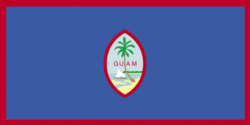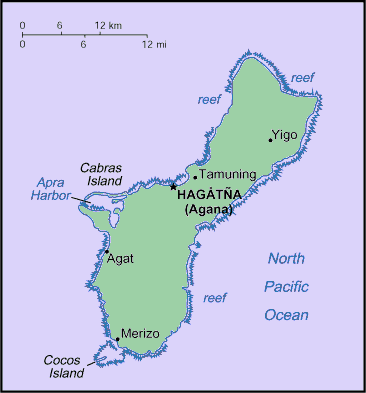Traveling Luck for Guam. Guam, Oceania
Guam is located in Oceania, island in the North Pacific Ocean, about three-quarters of the way from Hawaii to the Philippines.
Land in Guam is volcanic origin, surrounded by coral reefs; relatively flat coralline limestone plateau (source of most fresh water), with steep coastal cliffs and narrow coastal plains in north, low hills in center, mountains in south.
Guamanian land covers an area of 541.29999999999995 square kilometers which is three times the size of Washington, DC
 Guamanian national flag (Flag of Guam)
Guamanian national flag (Flag of Guam)
As for the Guamanian climate; tropical marine; generally warm and humid, moderated by northeast trade winds; dry season (January to June), rainy season (July to December); little seasonal temperature variation.
Guamanian(s) (US citizens) speak English 38.3%, Chamorro 22.2%, Philippine languages 22.2%, other Pacific island languages 6.8%, Asian languages 7%, other languages 3.5% (2000 census).
Places of note in Guam
 Guamanian map
Guamanian map
Regions of Guam
Guam was ceded to the US by Spain in 1898. Captured by the Japanese in 1941, it was retaken by the US three years later. The military installation on the island is one of the most strategically important US bases in the Pacific.
The economy depends largely on US military spending and tourism. Total US grants, wage payments, and procurement outlays amounted to $1.3 billion in 2004. Over the past 30 years, the tourist industry has grown to become the largest income source following national defense. The Guam economy continues to experience expansion in both its tourism and military sectors.
Guamanian natural resources include fishing (largely undeveloped), tourism (especially from Japan)
largest and southernmost island in the Mariana Islands archipelago; strategic location in western North Pacific Ocean
Guamanian religion is Roman Catholic 85%, other 15% (1999 est.).
Natural hazards in Guam include frequent squalls during rainy season; relatively rare, but potentially very destructive typhoons (June - December).

 Search
Search Guam country profile
Guam country profile